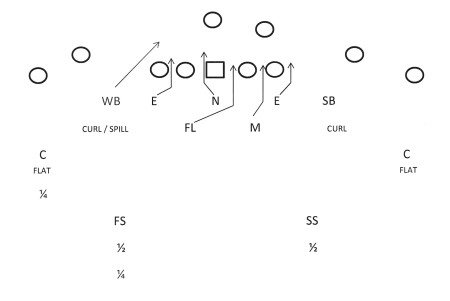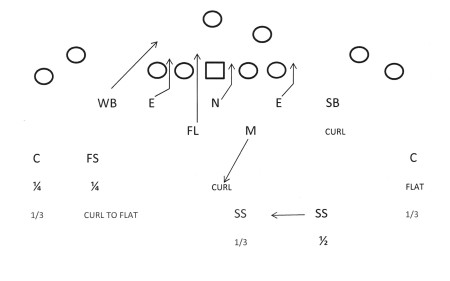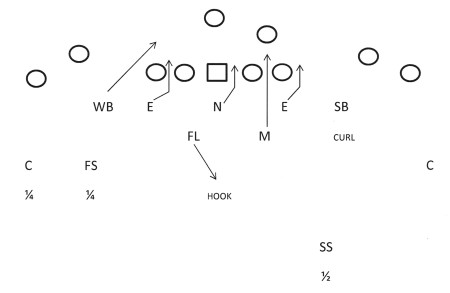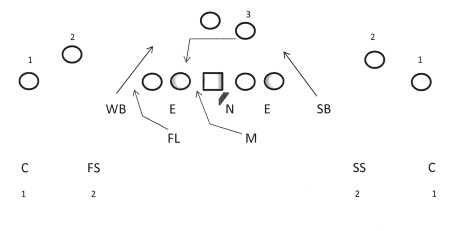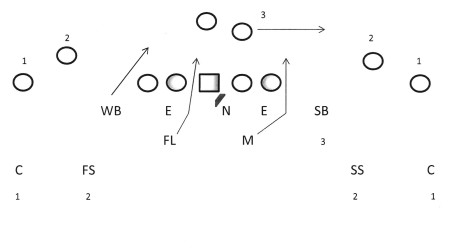Article CategoriesAFM Magazine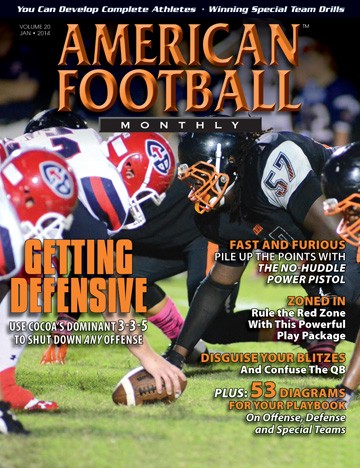
|
Confuse the Quarterback, Part II – Disguise your blitzes to stop the run and still defend the pass.by: Rey HernandezRetired High School and College Coach © More from this issue I never liked allowing a good zone read option quarterback to come to the line of scrimmage knowing how our secondary coverage was going to be aligned. I also thought it was important to give the offensive line and the blocking back a variety of pressure calls that were accompanied by some type of movement at the snap of the ball. Our goal was to use these calls to stop the run without significantly compromising the ability to defend the pass. In the cover 2 call, the WB plays curl and is assigned spill responsibility should the quarterback be flushed out of the pocket to his side. Besides basic cover 2, this blitz can be run with an inverted safety to the weak side and a 3-deep look on top. Off the 3-deep look, the secondary can also play man-free. The secondary can also play cover 4 (¼ ¼ ½ or ¼ ¼ across the board). Of course, zero coverage is always an option with the SB also coming off the edge. In zero coverage, the outside linebackers will be accountable for the running back should a screen option develop to their side. When checking into a cover 4 call, the two-deep hash safety will adjust from 14 yards off the ball to about nine yards and the rolled corner will loosen up and play a deep outside quarter responsibility. Because the WB is now on a force call, the corner and safety will play a banjo man read on the twins with both players reading the slot receiver (#2 counting from outside in). This will allow the defensive backs to use their combination recognition reads to get a jump on the developing routes to their side. Motion strong to trips can be covered with a strong safety invert to the trips side with cover 3 (three-deep) or Cover-4 (¼ ¼) coverage. Motion weak to trips will require a weak safety invert with cover 3 coverage. Because we are very active with our inside linebackers in this pressure package, both the Mac and Flip give pre-snap blitz looks in order to keep the offensive line guessing. In this blitz, Mac would creep toward the B-gap but pull out into coverage. A slide protection scheme would account for all the rushers but our hope is that our weakside linebacker will still prove to be problematic for them. One of our favorite coverage change-ups in this blitz is what we call a weak cover 1. This is a three-deep coverage with the safety inverted to the weak side instead of the strong side as is usually the case in a basic strong side, three-deep zone call. The strong safety will play a deep third and the free safety will invert to the weak side.
This is a pressure call that we like to use when we want to make sure that we will be forcing the outside linebacker away from the running back side. On the pre-snap read, the Mac will give a call to the defensive linemen that will slant them to the running back. In Diagram 3, the back is offset to the defense’s right side. The defensive line will slant right and the inside linebacker to the slant side will shoot the B-gap to this side. The force will be coming from the left side. In this case, it will be the weakside outside linebacker that will be forcing. This will increase the possibility that our weakside linebacker will be one-on-one with a defensive tackle. In Diagram 3, if the running back had been aligned to the defense’s left side, the line would slant left and the Flip would shoot his B-gap while the strongside outside linebacker would be forcing. In both scenarios, the secondary checks to quarter-quarter coverage to the force side. A three-deep call with an inverted safety to the force side is a possible change up in coverage along with a man-free call with the strongside linebacker in man coverage. Zero coverage would be the other option.
DIAGRAM 4: 50 Over Force Flow Read Man (Blitz) This is a pressure call out of what we call our Flow Read Package. The Flow Read Front has both outside linebackers off the edge on a hard force. There are a number of blitzes that can complement the double force. Both inside linebackers will be blitzing but their path of attack will be determined by the backfield flow. The gap-control front allows the defense to cancel gaps and the tilted nose will sometimes discourage offenses from running the strongside zone. From a defensive standpoint, what we like about this call is the fact that we have accounted for all the gaps on run and we have two linebackers coming hard off the edge. Based on down and distance tendencies, there are times when we will tell the outside linebackers to read the flow to determine which one will take a direct path to the QB and disregard any other play action. In Diagram 4 with flow away, the strongside linebacker would take a direct line to the QB.
DIAGRAM 5: 50 Over Force Flow Read Man (Blitz) With man coverage, we always stress the importance of tackling the back should he attempt to release through the interior gaps. Motion to empty would trigger quarter-quarter coverage across the board with the outside linebacker to the motion side coming off his force. The rest of the defenders would still execute their blitz tracks. In Diagram 4, if motion came to the weak side the WB would pick up motion to the trips side and all the gaps would still be cancelled with perimeter contain in place. If the trips came to the strong side, it would be considered flow right. The strongside linebacker would drop into coverage and Mac would contain over the top. Flip would shoot the weak B-gap. Diagram 5 shows this coverage adjustment versus motion to trips. It is my belief that it is also responsible for some of the basketball numbers that are being put on the scoreboard by zone read spread teams. Our practice planning always reduced full contact in small group sessions in favor of live 11-on-11 full contact sessions that were limited in repetitions but provided the defense with a much more realistic look at what they would be facing on game day. The concern associated with injuries in practice is a legitimate one but in light of the number of players that have been suffering serious injuries in semi-live not tackling to the ground sessions, it may be time to reconsider the way we prepare our defenses for these fast-tempo offenses. Could it be that conducting your 11-on-11 practice scout sessions under mostly semi-live conditions is not making the game any safer? It certainly isn’t preparing the defense for what they will actually have to do when it lines up against an opponent whose players they will have to block and tackle in a full contact setting. |
|
| HOME |
MAGAZINE |
SUBSCRIBE | ONLINE COLUMNISTS | COACHING VIDEOS |
Copyright 2024, AmericanFootballMonthly.com
All Rights Reserved


